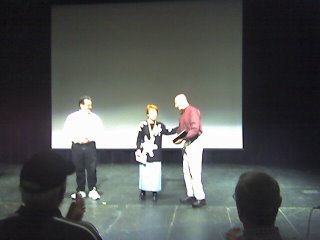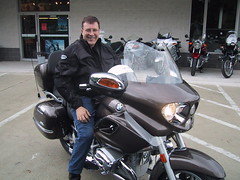Like any gathering of motorcycle riders, you can't escape the feeling of community--the feeling that you are somehow connected to a family. The twenty-degree weather, limited the number of motorcyclists who actually rode to the event, and I was pleased to see Ray Sufczynski show up on his 1150 RT, parking right behind me. A few spaces up I saw another BMW, a GS, belonging either to Chaz or to one of the younger riders in the Baltimore Metro-Washington club, Mike Wakefield whose known on the board as Slag both of whom I was glad to see inside.
Inside the Ann Arundel convention center, there were fellow students from last year's instructor training class, our instructors, the quality assurance team who ride herd on how things are done at all the training centers, and an instructor from my own Experienced riding class three years ago, Harry. While Harry and I were catching up, another instructor from that class walked in, Rodney Miller.
Rod was the chief salesman at Bob's BMW when I purchased my R-1200 CLC in May of 2003 as well as turning up as an ERC instructor at the subsequent class. The salesman who handled my sale, Carter, was off the day that I picked up the bike and it was Rodney who quietly and thoroughly walked me through what I needed to check each time I rode, and the other features of the BMW. A few weeks later, when I made it to the experienced rider course that Bob's promoted, Rodney and Harry helped make sure that I got off to a good start on a bike twice as big as any I had ridden previously.
I was dreaming of a ride to the West Coast. Chris Zink, who works at Johns Hopkins and who has a thriving business in lectures and books about agility training for dogs was also in the class. Hearing my thoughts, she suggested returning via Banff. "The most beautiful place in North America," she said. And so she figured in the ride I made west and back a few weeks later.
I was riding through Montana on my west and called back to Bob's to leave word that all was well. I asked for Rodney, and after an awkward few moments learned that Rodney was in the hospital. Knowing that a seasoned rider like him could be hurt reminded me that I needed to redouble my own attention to the road. A few hours later, that July 3rd morning, a drunk driver came across the oncoming lanes and entered the Westbound lanes without looking and took out a car ahead of me. I knew that it was largely due to that mornings renewed focus on increasing my safety margin that kept me from from being closer to that accident and maybe going to the morgue with the driver of the car ahead of me. It was a big relief, in the days that followed, to hear that Rod was recovering well.
By the way, it was only ten in the morning. The bar was miles from town and had a full parking lot on a weekday morning. Traffic was light enough that drunks up there probably expect people on the highway to yield to merging traffic.
So, it was like a family reunion in many ways, but with many new "relatives" to meet.
 Later, in the conference, Rodney was called up to the stage to be the first recipient of the Richard Schreiner Memorial Award for the contributions he had made to motorcycle safety education in Maryland.
Later, in the conference, Rodney was called up to the stage to be the first recipient of the Richard Schreiner Memorial Award for the contributions he had made to motorcycle safety education in Maryland.The program also included Tim Kerns, of The National Study Center (NSC). Tim clued me in to some of the powerful interests who are beginning to pay more attention to the costs of motorcycle crashes. One of the things I could see from his charts is that although the average age of the population of motorcycle riders is moving higher, the largest number of fatalities were among those 25 to 29 years old. The numbers stay high then fall off rapidly after age 49.
Statistics are useful as they may at least prompt us to think.
Peter Moe, of Maryland's Highway Safety Office (MHSO), spoke of how Maryland and national figures correlated. Later in the day we heard about Federal monies being given to States to investigate motorcycle safety issues.
Both of the speakers were intent on how to communicate better to the younger riders who tend to ride edgier machines.
The interest of many across the country in teaching motorcycle safety is not because of the hourly rate at which instructors are reimbursed. Watching the more experienced instructors, they were definitely enjoying the day and each others company, but there were definitely serious undertones. They love the ride and want to do whatever they can to help riders avoid accidents like they have had, some of their friends such as Rod have had, and perhaps other who are no longer with us.
While we need to focus most on the things each of us can control to promote our own safety, things such as our own attitudes and habits, perhaps there will be some renewed focus on the attitudes and habits of automobile riders. Send me your thoughts. Start a thread on motorcycle riding forums that you read, on-line. Let's see if we can find some innovative improvements. What about the left shoulder of freeways being designed and policed for the use of motorcycle riders and our being allowed another 5 mph of speed in that lane, for example?
Age wasn't the only thing I noticed. Gender diversity is also a very good thing. That lady instructor on the white Harley didn't have the luxuries of BMW's heated seats and grips. Have to give some credit to those Road King riders who can keep up with BMW's.

No comments:
Post a Comment